Mortality, health, and poverty: the unmet needs of people on probation and parole
Unique survey data reveal that people under community supervision have high rates of substance use and mental health disorders and extremely limited access to healthcare, likely contributing to the high rates of mortality.
by Emily Widra and Alexi Jones, April 3, 2023
Research shows that people on probation and parole have high mortality rates: two and three times higher than the public at large.1 That certainly suggests that our community supervision systems are failing at their most important — and basic — function: ensuring people on probation and parole succeed in the community.
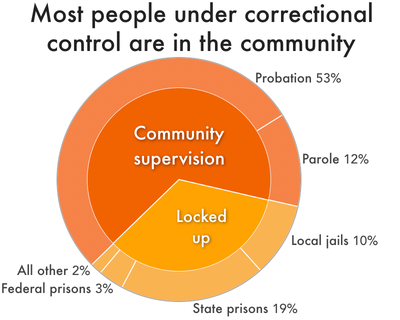
With a similar approach to our recent series regarding the needs of people incarcerated in state prisons, we did a deep dive into the extensive National Survey on Drug Use and Health (NSDUH). The results of this survey, administered by the U.S. Department of Health and Human Services’ Substance Abuse and Mental Health Services Administration (SAMHSA), provide key insights into these specific — and often unmet — needs faced by people under community supervision. Because this survey asks respondents if they were on probation or parole in the past 12 months, this dataset comes closer than any other source 3 to offering a recent, descriptive, nationally representative picture of the population on probation and parole.2
The data that we uncovered — and the analyses of this same dataset by other researchers discussed throughout — reveal that people under community supervision have high rates of substance use4 and mental health disorders and extremely limited access to healthcare, likely contributing to the high rates of mortality. Moreover, the data show that people on probation and parole experience high rates of chronic health conditions and disability, are extremely economically marginalized, and have family obligations that can interfere with the burdensome — often unnecessary — conditions of probation and parole.
Substance use and mental health
Three in 10 people under community supervision have substance use disorders, four times the rate of substance use disorders in the general population. Similarly, 1 in 5 people under community supervision has a mental health disorder, twice the rate of the general population.
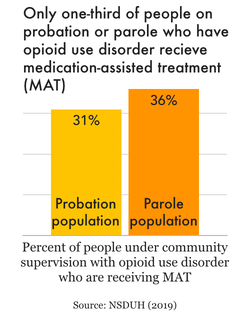
In addition, NSDUH data illustrate that most people on probation and parole do not have adequate access to healthcare, implying that probation and parole offices are failing to match people with the services they need to succeed in the community. Nearly one-third of people on probation and parole with a mental health disorder report an unmet need for mental health treatment. Over two-thirds of people with substance use disorders report needing treatment, but not receiving it. Similarly, only about one-third of people on community supervision with opioid use disorder report receiving medication-assisted treatment (MAT), the “gold standard” of care.
Finally, many people on probation and parole have no health insurance, even though many people on probation and parole have incomes low enough to qualify them for Medicaid.6 25% of people on probation and 27% of people on parole were uninsured at the time of this survey. This lack of treatment access reported by people under community supervision represents a massive failure of probation and parole offices.
Physical health and well-being
Criminal legal system involvement is concentrated among people who are socioeconomically disadvantaged and these same populations are at an elevated risk for a number of negative health outcomes. Public health researchers Winkelman, Phelps, Mitchell, Jennings, & Shlafer (2020) analyzed the same NSDUH data (but from 2015-2016) and found that people under community supervision are more likely to report fair or poor health, more chronic conditions, a diagnosis of COPD, hepatitis B or C, or kidney disease than people in the general population.
The community supervision population also has higher rates of disabilities, with particularly high rates of cognitive disabilities.7 Such disabilities can interfere with individuals’ ability to keep track of the 18 to 20 requirements a day people on probation must typically comply with. The particularly high rates of all types of disabilities among people on probation and parole also reflects the larger pattern of criminalizing people with disabilities.
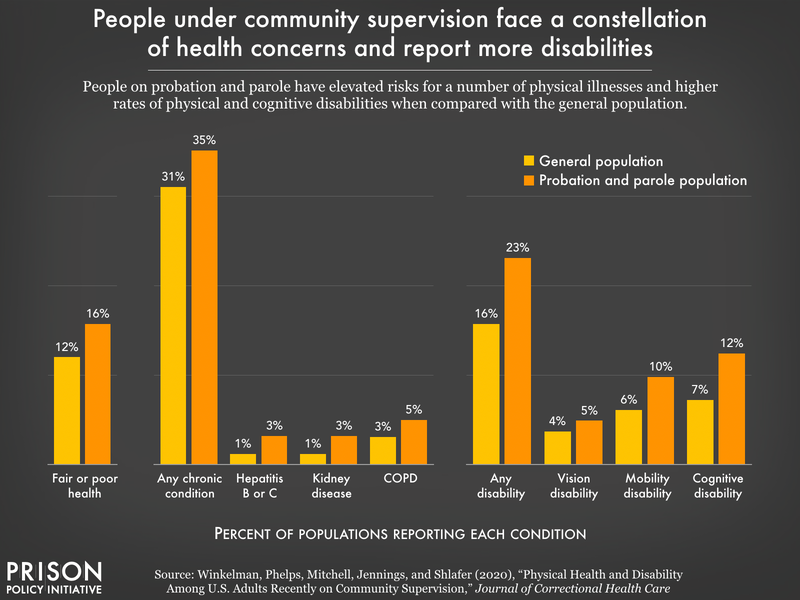
Economic disadvantage, education, and children
The NSDUH data also indicate that people on probation and parole are extremely economically marginalized, which can interfere with probation and parole conditions. 3 out of 5 people on probation have incomes below $20,000 per year, with women and Black people having among the lowest incomes. More than half have a high school education or less. And people on probation and parole are three times more likely to be unemployed than the general population. Yet, as we have discussed before, people on probation and parole are required to pay unaffordable fees and costs associated with their supervision conditions (such as drug testing or ignition interlock devices), even though many are living well below the poverty line.
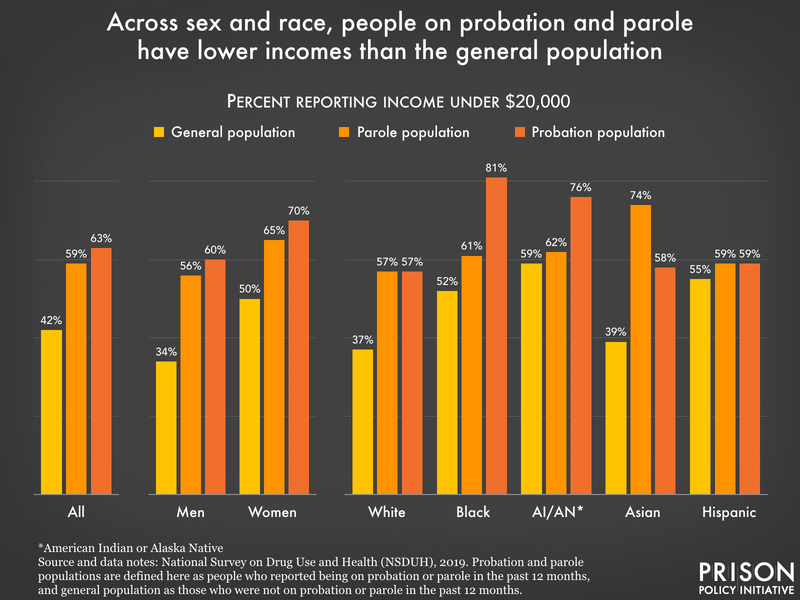
Finally, the data reveal that many people — and more than half of women — on probation and parole have children. Yet, probation and parole requirements almost never consider childcare or eldercare responsibilities when setting supervision conditions, even as some states require courts to consider a defendant’s caretaker status when considering a sentence to incarceration.
| General population | Probation population | Parole population | |
|---|---|---|---|
| High school education or less |
33% | 52% | 57% |
| Unemployed | 3-4% | 11% | 15% |
| Have children | 41-42% | 46% | 43% |
| Men | 40% | 43% | 41% |
| Women | 43% | 54% | 50% |
Conclusions
Probation and parole systems are failing to link people to the healthcare they need, despite all the evidence showing disproportionate rates of serious illness and death within supervised populations. These “alternatives” to incarceration, ostensibly created to help people address the problems that led to their conviction in a community setting, also set people up to fail with burdensome, often unnecessary requirements that show little regard for people’s individual circumstances, including low incomes and childcare obligations. The clearest example of these counterproductive conditions is the requirement to abstain from drugs or alcohol; given that so many supervised people with substance use disorders do not receive treatment, what hope do they have of staying out of jail when a positive drug test may constitute a “violation”? Probation and parole systems can’t be seen as true “alternatives” until they are overhauled to support people’s medical and personal needs instead of simply monitoring and punishing their mistakes. Until then, state and local governments should double down on their investments in diversion programs that are proven to connect people with care — and, to that same end, keep people out of courts and jail as much as possible.
Footnotes
-
People on probation are also 3 times more likely to die than people in jails and state prisons over a given time period, adjusted for age (the study this was based on used data from 2001-2012). ↩
-
The Bureau of Justice Statistics conducts the Annual Probation Survey and Annual Parole Survey, which also provides a recent, descriptive, and nationally representative picture of the community supervision population. The demographic details available from the NSDUH are richer, however, going far beyond race, sex, age, and offense type. Moreover, the NSDUH presents self-reported data, while the BJS surveys present administrative data reported by probation and parole agencies. ↩
-
For the purposes of this analysis, we chose to use data collected in the 2019 NSDUH rather than the more recent 2020 survey results. In the 2020 NSDUH report, the authors cautioned that “care must be taken when attempting to disentangle the effects on estimates due to real changes in the population (e.g., the coronavirus disease 2019 [COVID-19] pandemic and other events) from the effects of these methodological changes.” Because of this warning, we elected to use 2019 NSDUH so that our results could be better compared over time. Researchers updating our work in the future, however, should note one important methodological change occurred in 2020: “2020 marked the first year in which substance use disorders (SUDs) were evaluated using criteria defined in the Diagnostic and Statistical Manual of Mental Disorders, 5th edition (DSM-5), as opposed to criteria specified in the Diagnostic and Statistical Manual of Mental Disorders, 4th edition (DSM-IV).” ↩
-
“Substance use disorders” in this analysis were evaluated by the using criteria from the Diagnostic and Statistical Manual of Mental Disorders, 4th edition (DSM-IV). See footnote 3 for more information. ↩
-
The data on offense type for people on probation and parole used here from the Bureau of Justice Statistics, defines “violent” offenses as domestic violence offenses, sex offenses, or other violent offenses. However, generally, the distinction between “violent” and other crime types is a dubious one; what constitutes a “violent crime” varies from state to state, and acts that are considered “violent crimes” do not always involve physical harm. The Justice Policy Institute explains many of these inconsistencies, and why they matter, in its comprehensive and relevant report, Defining Violence. ↩
-
In all states, Medicaid provides health coverage for low-income people who qualify based on income, household size, disability status, and a handful of other factors. Most people in contact with the criminal legal system are likely eligible for Medicaid: People in prisons and jails are among the poorest in the country and have high rates of disabilities, making them likely eligible for Medicaid in almost every state. People in contact with the criminal legal system have drastically lower pre-incarceration incomes than people who are never incarcerated. In fact, 32% of people in state prisons in 2016 who had insurance at the time of their arrest were covered by Medicaid (compared to about 19% of insured people nationwide). As an additional indicator of need among this population, 50% of people in state prisons were uninsured at the time of their arrest. ↩
-
In this dataset, “cognitive disabilities” are defined as “serious difficulty concentrating, remembering, or making decisions.” ↩
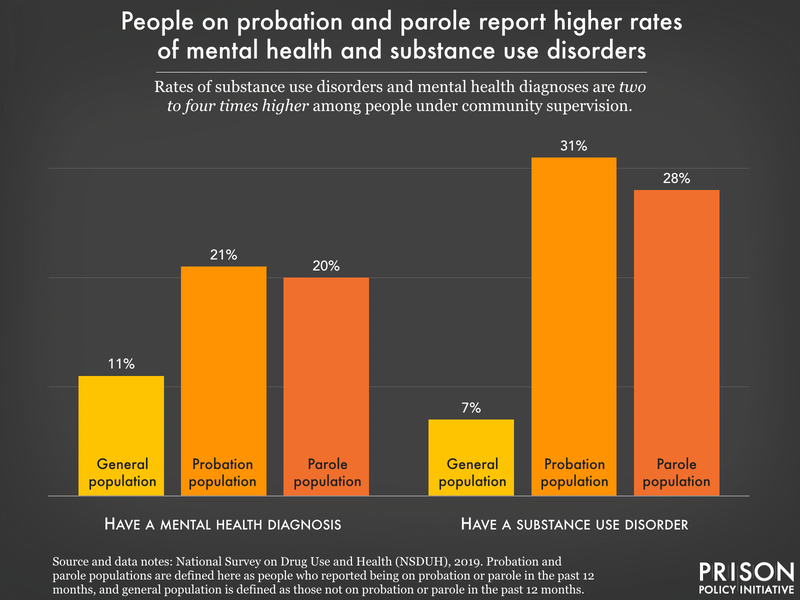
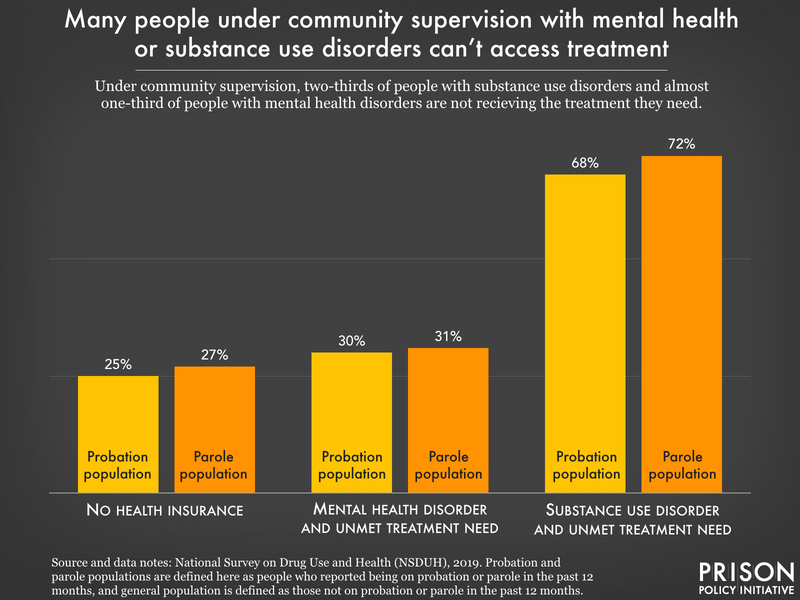





Regardless of the study findings it doesn’t change policy. Federal supervision policy is compliance at the expense of health. If someone violates a restriction they are punished and often retuned to jail and resentenced prolonging incarceration and rehabilitation. Punishment not rehabilitation is the goal. Therefore health is inconsequential.